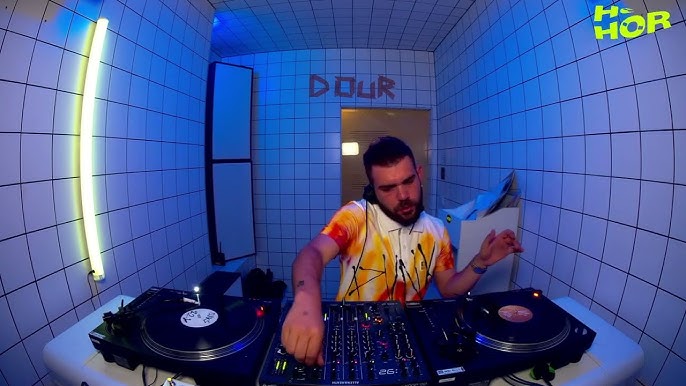Let’s get the answer out of the way….
Generally, vinyl is going to have more detail and better reproduce the frequency range of human hearing (20Hz – 20kHz) than many digital formats. I would say one of the most important aspects to vinyl isn’t just the record itself, but the culture and the ‘intention’ surrounding the practice of collecting (or cratedigging), hauling, playing, and just generally going through the pain of vinyl vs. a silly USB attached to your keychain. Vinyl’s advantages itself are oftentimes coupled with a quality turntable(ahem* Technics SL-1200MK2), a discerning music selector, a hi–fidelity or high quality amplifier coupled with strong 2-channel or distributed Audio. It’s the first choice in a larger, grander, detailed ecosystem of people who generally give a s**t…..so that’s why vinyl sounds so good.

Despite the convenience and ubiquity of digital formats, many argue that vinyl offers a listening experience that’s unparalleled in its warmth, depth, and authenticity. This article delves into the reasons behind vinyl’s enduring appeal, exploring both the subjective experience and the technical factors that contribute to its unique sound quality.
Whether it’s right or wrong, I find myself associating vinyl and DJs that play vinyl with certain venues here in Brookly and further abroad.
I think of Public Records in Gowanus, I think of Heideglühen and Club der Visionaere in Berlin, I think of my pal Armando’s overly complicated mixing setup in his apartment in Williamsburg. I don’t think of Berghain, or Basement, or Unter. While I’m certain that MP3s have snuck their way into Public Records, I’m also certain that Freddy K has played a heck of a lot of vinyl at Berghain….but it’s just something about these places that sticks with me in this way.
So, my musings aside, let’s review some of the components of the Vinyl listening experience and the comparison to the digital and also Live formats.

Vinyl Records: The Analog Alternative
In our discussion of digital audio compression, lossless compression, and live music, vinyl records present an interesting middle ground. As an analog format, vinyl offers a distinct listening experience that differs from both MP3s and live performances.
Key Characteristics of Vinyl Sound:
Frequency Response:
– Theoretical range of 20 Hz to 20 kHz, similar to human hearing
– Practically, many records have a usable range of about 30 Hz to 18 kHz
Dynamic Range:
– Typically around 60-70 dB, which is less than digital formats but more than many MP3s
Harmonic Distortion:
– Introduces subtle distortions that many listeners find pleasing
– Can add a perceived “warmth” to the sound
No Digital Compression:
– Avoids the data loss associated with lossy digital formats like MP3. We review Digital Compression in our post on Audio File format ranking
How Vinyl Compares:
Vs. MP3:
– Generally offers fuller frequency response and dynamics
– Provides a more “open” sound with better stereo imaging
– Lacks the digital artifacts sometimes present in MP3s and other downsides to MP3s
Vs. Live Music:
– Cannot capture the full dynamic range of live performances
– Misses some of the spatial cues and physical sensations of live sound
– Playback is affected by the quality of the turntable and audio system
Neurological and Cognitive Effects:
Engagement and Intention:
– The ritual of playing a record (selecting it, placing it on the turntable, etc.) can increase listener engagement
– This heightened engagement may lead to more focused listening and potentially stronger emotional responses
Brain Activity:
– The analog nature of vinyl may stimulate the brain differently than digital formats
– Some studies suggest that analog sound activates more areas of the brain compared to heavily compressed digital audio
Nostalgia Factor:
– For some listeners, vinyl can trigger nostalgic responses, potentially enhancing emotional connection to the music
Cognitive Load:
– The presence of subtle background noise (surface noise, crackles) might actually enhance attention for some listeners
– This is based on the concept of stochastic resonance, where a certain level of noise can enhance signal detection
Fatigue:
– Some listeners report less fatigue when listening to vinyl compared to digital formats, possibly due to the absence of certain types of distortion present in digital audio
Practical Considerations:
Variability:
– Each playback of a vinyl record is slightly different due to factors like dust, wear, and stylus placement
– This variability can make each listening session unique, potentially increasing engagement
Limited Portability:
– Unlike MP3s, vinyl can’t be easily transported or played in various environments
– This often results in more deliberate, focused listening sessions
Quality Dependencies:
– The listening experience is highly dependent on the quality of the pressing, playback equipment, and maintenance
– High-end vinyl setups can provide exceptional audio quality, rivaling or surpassing high-resolution digital formats

Conclusion:
Vinyl records occupy a unique space in the audio landscape. While they can’t replicate the full experience of live music, they offer a different kind of listening experience compared to digital formats like MP3. The analog nature of vinyl, combined with its ritual aspect and unique sound characteristics, can provide a rich, engaging listening experience that many find cognitively and emotionally satisfying.
For the brain, vinyl might represent a middle ground – offering more detail and dynamics than typical MP3s, while still being a reproducible, home-listening format. The specific effects on mood, energy, and cognition likely vary between individuals, influenced by factors like personal preference, nostalgia, and the quality of the listening setup.
As with all audio formats, the key is variety. Experiencing music through different mediums – be it live, vinyl, or digital – can provide our brains with a rich tapestry of auditory stimuli, potentially enhancing our overall relationship with music.
— immersion audio —
